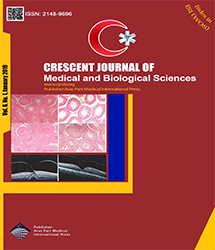| Original Article | |
| Investigation the Spermatogenesis and Testis Structure in Diabetic Rats After Treatment With Galega officinalis Extract | |
| Farnaz Shokri1, Majid Shokoohi2, Hamid Reza Niazkar3, Ayda Roudi Rasht Abadi4, Hossein Kalarestaghi5, Maliheh Ahin6 | |
| 1Women’s Reproductive Health Research Center, Tabriz University of Medical Sciences, Tabriz, Iran 2Department of Anatomical Sciences, Faculty of Medicine, Tabriz University of Medical Sciences, Tabriz, Iran 3Student Research Committee, Gonabad University of Medical Sciences, Gonabad, Iran. 4Department of Animal Biology, Faculty of Biology, University of Kharazmi, Tehran, Iran 5Department of Anatomy and Pathology, Research Laboratory for Embryology and Stem Cell, Faculty of Medicine, Ardabil University of Medical Sciences, Ardabil, Iran 6Taleghani Hospital, Tabriz University of Medical Sciences, Tabriz, Iran |
|
|
CJMB 2019; 6: 031-036 Viewed : 5990 times Downloaded : 3145 times. Keywords : Oxidative Stress, Diabetes, Galega officinalis, Testis, Sperm parameters |
|
| Full Text(PDF) | Related Articles | |
| Abstract | |
Objectives: This study aimed to evaluate the anti-oxidative potential of Galega officinalis extract on oxidative damages in the testes and sperm parameters of diabetic rats. Materials and Methods: In this experimental study, 32 male Wistar rats were segregated in 4 groups: Control, Diabetic control, Diabetic treated with G. officinalis extract and healthy group that received G. officinalis extract. An instillation of distilled water was performed in the control and diabetic groups. Also, treatment groups received Galega extract (50 mg/kg body weight) for 8 weeks. After treatment period all of subjects were anesthetized, their blood samples were taken, the serum level of insulin and glucose were measured then the testicles and epididymis were removed and sperm parameters and oxidative stress markers were assessed. Results: Treatment of diabetic rats with G. officinalis extract significantly increased the Johnson score and diameter of seminiferous tubule as well as reduced the glucose plasma levels (P = 0.001) and increased the insulin levels (P = 0.001). Furthermore, during diabetes an upsurge in the level of malondialdehyde (MDA) and a decrease in the levels of superoxide dismutase (SOD) and catalase (CAT) enzymes activity were observed in the testes. Administration of G. officinalis extract (50 mg/kg BW) significantly rectified these parameters (P < 0.05). Moreover, the sperm parameters decreased in the diabetic group, while the use of G. officinalis significantly improved the mentioned disorders in the treatment groups (P < 0.05). Conclusions: The results of this study confirm the antioxidant role of hydroalcoholic extract of G. officinalis in the improvement of the testicular oxidative damage caused by diabetes. |
Cite By, Google Scholar
Google Scholar
PubMed
Online Submission System
 CJMB ENDNOTE ® Style
CJMB ENDNOTE ® Style
 Tutorials
Tutorials
 Publication Charge
Medical and Biological Research Center
About Journal
Publication Charge
Medical and Biological Research Center
About Journal
Aras Part Medical International Press Editor-in-Chief
Arash Khaki
Deputy Editor
Zafer Akan


















